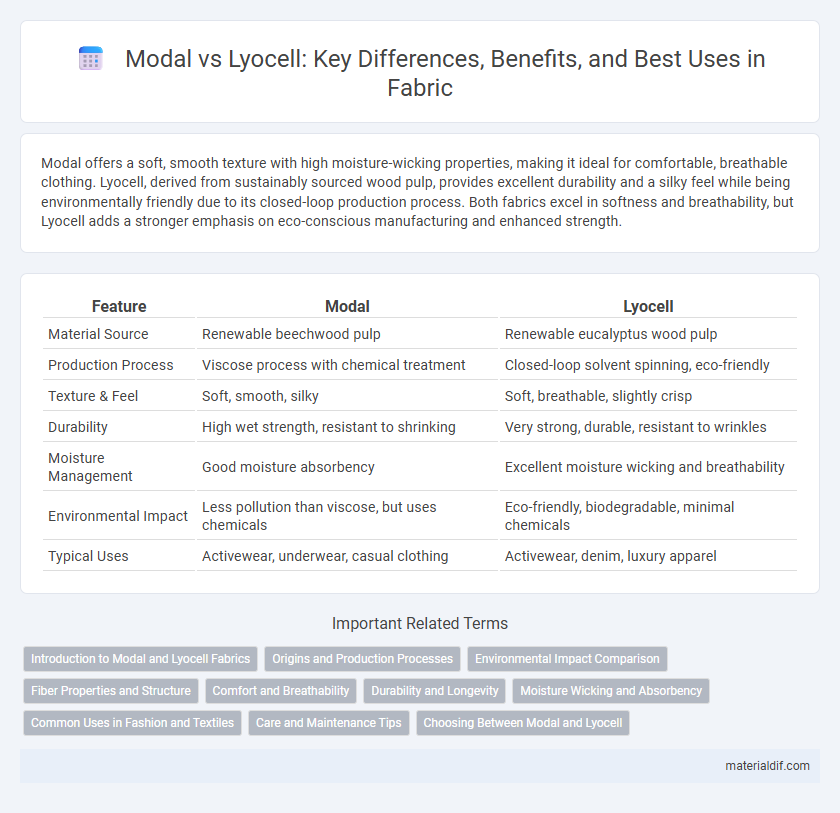Modal offers a soft, smooth texture with high moisture-wicking properties, making it ideal for comfortable, breathable clothing. Lyocell, derived from sustainably sourced wood pulp, provides excellent durability and a silky feel while being environmentally friendly due to its closed-loop production process. Both fabrics excel in softness and breathability, but Lyocell adds a stronger emphasis on eco-conscious manufacturing and enhanced strength.
Table of Comparison
| Feature | Modal | Lyocell |
|---|---|---|
| Material Source | Renewable beechwood pulp | Renewable eucalyptus wood pulp |
| Production Process | Viscose process with chemical treatment | Closed-loop solvent spinning, eco-friendly |
| Texture & Feel | Soft, smooth, silky | Soft, breathable, slightly crisp |
| Durability | High wet strength, resistant to shrinking | Very strong, durable, resistant to wrinkles |
| Moisture Management | Good moisture absorbency | Excellent moisture wicking and breathability |
| Environmental Impact | Less pollution than viscose, but uses chemicals | Eco-friendly, biodegradable, minimal chemicals |
| Typical Uses | Activewear, underwear, casual clothing | Activewear, denim, luxury apparel |
Introduction to Modal and Lyocell Fabrics
Modal fabric, a semi-synthetic fiber derived from beech tree pulp, offers exceptional softness, breathability, and moisture-wicking properties, making it ideal for comfortable clothing and bedding. Lyocell, produced from sustainably sourced eucalyptus trees through an eco-friendly closed-loop process, boasts superior strength, biodegradability, and excellent moisture absorption. Both Modal and Lyocell fabrics are celebrated for their sustainable production methods and luxurious feel, appealing to environmentally conscious consumers seeking high-performance textiles.
Origins and Production Processes
Modal fabric is derived from beech tree pulp through a chemical-intensive process involving carbon disulfide, resulting in a soft, breathable textile. Lyocell originates from eucalyptus, oak, and birch wood, produced via an eco-friendly closed-loop process using non-toxic solvents that recycle over 99% of chemicals. Both fabrics belong to the rayon family but differ significantly in sustainability and environmental impact due to their distinct production methods.
Environmental Impact Comparison
Modal fabric production consumes less water and energy compared to conventional cotton, but it often involves chemical-intensive processes that can harm ecosystems if not managed responsibly. Lyocell, derived from sustainably sourced wood pulp, uses a closed-loop production system that recycles most solvents, significantly reducing water pollution and chemical waste. In environmental impact assessments, Lyocell is generally favored for its biodegradability and lower overall ecological footprint, making it a more sustainable fabric choice.
Fiber Properties and Structure
Modal fibers are derived from beech tree pulp, featuring a semi-synthetic cellulose structure that offers high tensile strength, excellent moisture absorption, and a soft, smooth texture ideal for breathable fabrics. Lyocell fibers, produced from sustainably sourced eucalyptus wood using a closed-loop process, exhibit a highly crystalline cellulose structure providing superior durability, enhanced moisture-wicking capabilities, and a silky feel with natural wrinkle resistance. Both fibers outperform traditional cotton in strength and moisture management, but Lyocell's environmentally friendly production and finer fiber diameter contribute to a more eco-conscious and breathable fabric choice.
Comfort and Breathability
Modal fabric offers exceptional softness and moisture-wicking properties, making it highly comfortable for daily wear. Lyocell, derived from eucalyptus trees, enhances breathability and has superior moisture management, which keeps the skin cool and dry. Both fabrics provide sustainable and eco-friendly options, but Lyocell outperforms Modal in airflow and temperature regulation.
Durability and Longevity
Modal fabric, made from beech tree pulp, exhibits high durability with its resistance to shrinkage and pilling, ensuring long-lasting wear. Lyocell, derived from eucalyptus trees, offers exceptional strength and moisture-wicking properties, enhancing its longevity under frequent use. Both fibers outperform traditional cotton in durability, yet Lyocell's eco-friendly production process and robust tensile strength often provide a slight edge in sustained fabric performance.
Moisture Wicking and Absorbency
Modal fabric excels in moisture absorbency, drawing sweat away from the skin to keep the wearer dry and comfortable, while Lyocell offers superior moisture-wicking properties by efficiently moving moisture through the fabric to accelerate drying. Both fibers are derived from cellulose but Modal's denser fiber structure enhances water retention, making it ideal for garments requiring softness with moderate breathability. Lyocell's open fiber network allows for greater airflow and faster evaporation, which benefits activewear and performance textiles where moisture management is critical.
Common Uses in Fashion and Textiles
Modal fabric is widely used in fashion for its softness and breathability, making it ideal for activewear, underwear, and casual clothing. Lyocell is favored in sustainable fashion due to its eco-friendly production and versatility, often found in shirts, dresses, and denim. Both fibers offer moisture-wicking properties, with Modal excelling in stretch and comfort, while Lyocell provides durability and a smooth texture suitable for high-end textile applications.
Care and Maintenance Tips
Modal fabric requires gentle machine washing in cold water with mild detergent, and should be air-dried or tumble-dried on low heat to prevent shrinking and maintain softness. Lyocell fabric benefits from washing in cold water on a gentle cycle, avoiding bleach, and should be hung to dry or laid flat to retain its smooth texture and strength. Both fabrics respond well to minimal ironing on low temperatures and should be stored in a cool, dry place to preserve their longevity.
Choosing Between Modal and Lyocell
Modal fabric, derived from beech tree pulp, offers exceptional softness and high moisture absorption, making it ideal for comfortable clothing and bedding. Lyocell, sourced from eucalyptus trees, features superior breathability and eco-friendly production with closed-loop processing, appealing to sustainability-focused consumers. Choosing between Modal and Lyocell depends on prioritizing softness and durability versus environmental impact and moisture management in fabric selection.
Modal vs Lyocell Infographic

 materialdif.com
materialdif.com